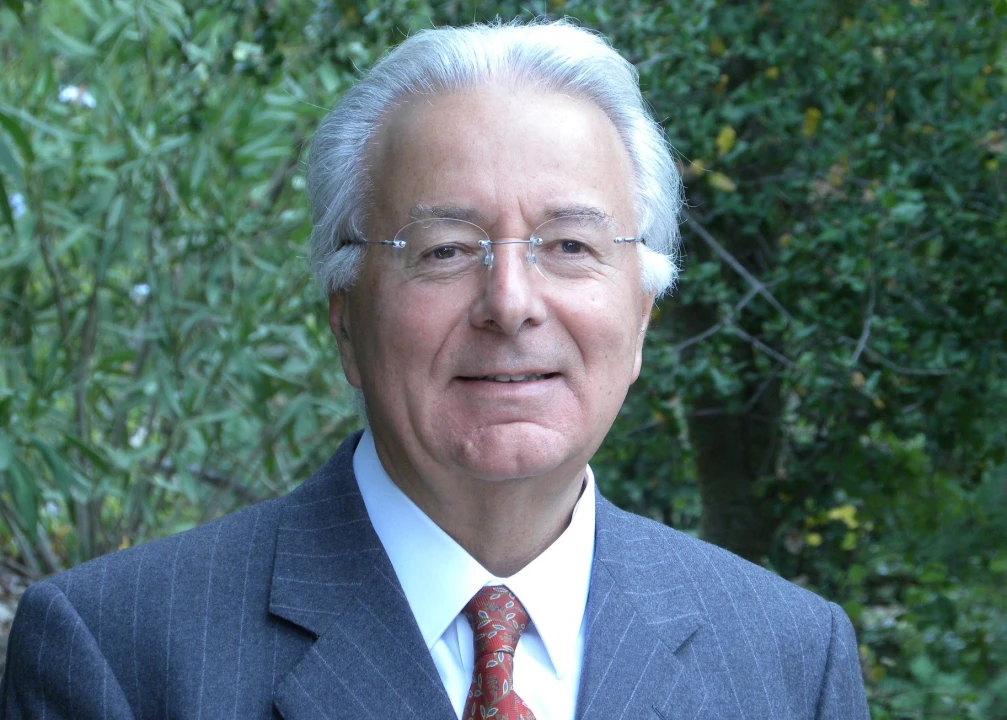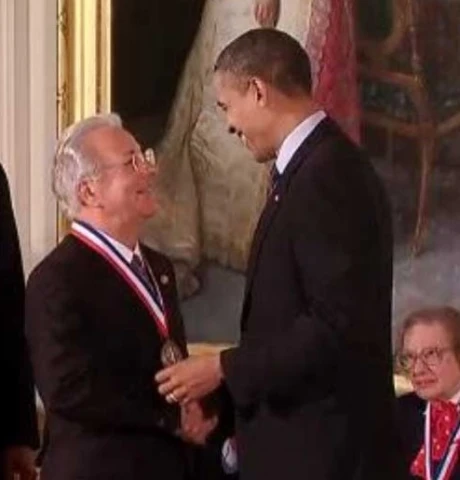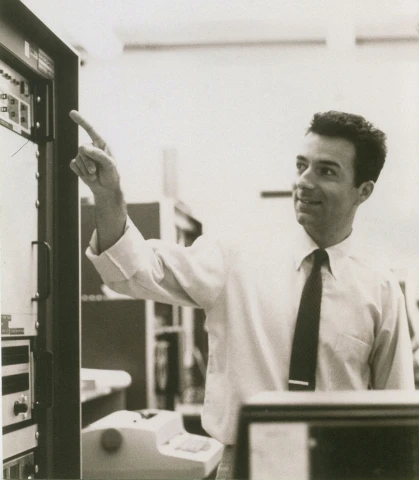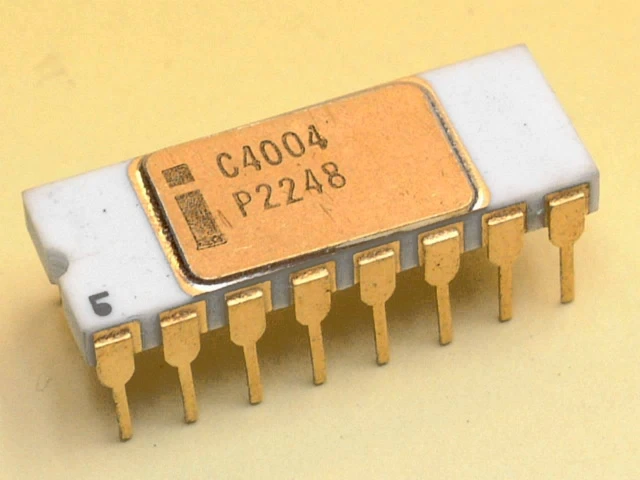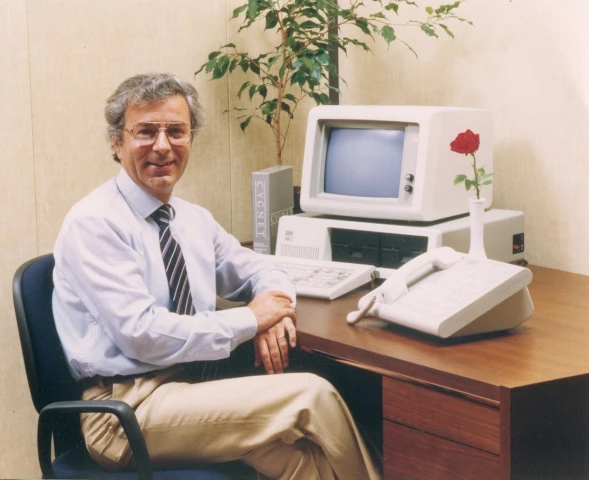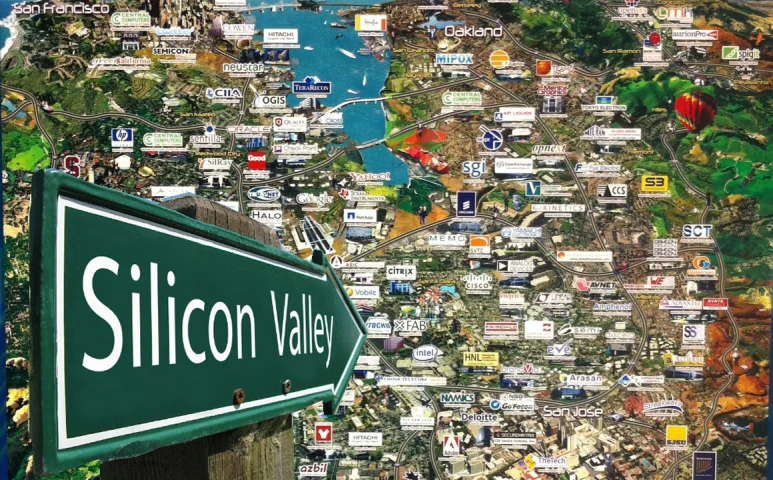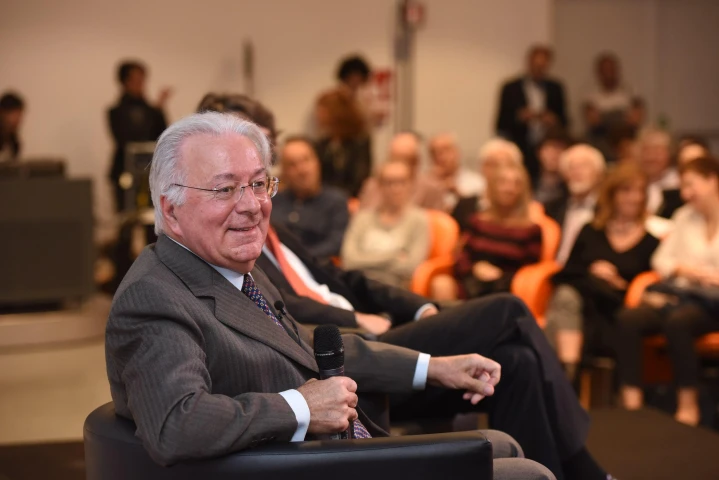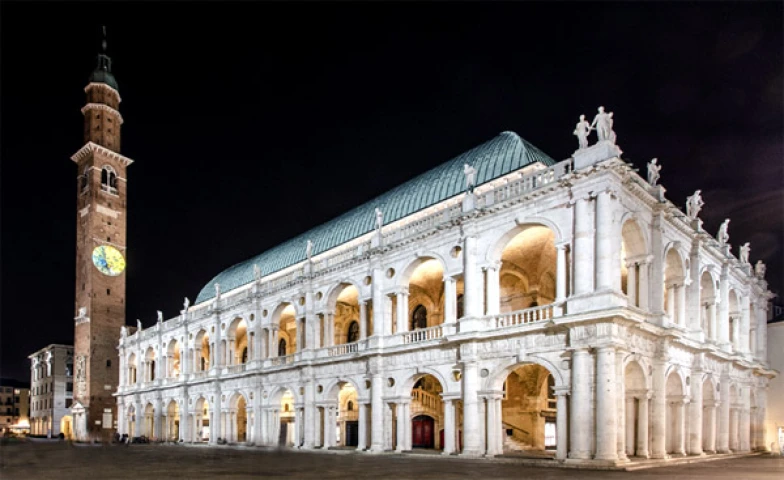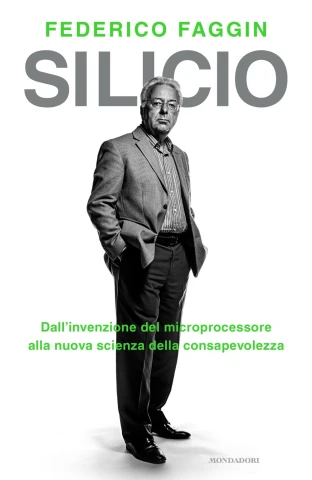It's not every day that you meet someone who has actually changed the world. Maybe, as I recall, for me it's the first time, even if our chat took place on the phone, connecting Italy and California thanks to some devices all equipped with (at least) one microchip. And Federico Faggin, the creator of the first microchip in history, is the protagonist of this interview. He is a wonderful Italian who immigrated to America some time ago, an extraordinary testimonial of how exceptional things happen when Italy and the United States meet, who just last June 8th was the protagonist of a beautiful event in Vinci, Leonardo's homeland, organized by our friend Roberto Bonzio, facilitator of this interview as well (thanks Roberto!)
Mr. Faggin, it was 1971 when you started a digital revolution, creating the first microchip ever, called Intel 4004. Silicon Valley owes its name to you, at least in part. At that point you were already a product of the excellent union between Italy and the United States, having been born and raised in Italy but then having refined your working knowledge in California. In those six months when you took over the project and completed it, was the historical scope of what you were doing clear to you?
Of course, it was clear to me from the beginning that the microprocessor would be a revolutionary product, even if this were not a real invention because it was already talked about as something that would be realized in the future. But it was necessary to have a new manufacturing technology that would make it possible. This technology was my first project at Fairchild Semiconductor just having arrived in California in early 1968. There I invented the MOS technology with silicon gate, technology that allowed making all the pieces necessary to make a monolithic computer, including the microprocessor. The world's first microprocessor was called Intel 4004. I designed it mostly by myself using my own key ideas and was in charge of its realization at Intel in 1970-71.
The microprocessor had a huge impact because it revolutionized the way we design electronic systems and opened up a multitude of new applications that were previously impossible. I must say, however, that reality far exceeded my expectations for the speed with which the microprocessor was adopted and for the novelty of the many products made possible for the first time. For example, I hadn't imagined the advent of the Internet which, in order to be transformative, would require hundreds of millions of people to have their own computers at their disposal.
With regard to the Internet, it was almost impossible to predict the future because the dynamics at stake were completely new and required not only the creation of the first personal computers, but above all their diffusion to levels so widespread as to be considered impossible at the time. Then it was necessary to connect the computers to each other, which could be done on an institutional level, but not on a large scale for private users. With the invention of the World Wide Web in the 1990s, the rise of the Internet was literally breathtaking.
The microprocessor was really a fundamental invention because it allowed reducing the size, the energy consumption and the cost of a computer to the point that even a toothbrush could contain a powerful computer. Our world has literally changed. Just look at the influence of smartphones that now dominate the scene and that almost every person has in their pocket today. Forty years ago, the electronics contained in one of these mobile phones would have occupied an entire building of 2000 square meters.
How much Italian is there in the creativity, genius and stubbornness that led you to create the Intel 4004, and then to deal with the development of all the microprocessors of the first five years of Intel's history, then to create the first integrated data-voice communication and again the first touchpads and touch screens?
Let's say that at the base of all this there was a great passion that motivated me to carry on the knowledge, the technologies, the new devices and the new ways to interact with the machines. Everything then happened according to circumstances.
When I started working at Olivetti in 1960, I never expected that the design and construction of a computer the size of a cabinet would lead me in just 10 years to a degree in physics, the development of new MOS technology, the first microprocessor and then ten more years of innovation giving rise to the first four generations of microprocessors.
The creation of the first touchpads and touchscreens, of which I am co-inventor, have then irreversibly changed the way we interact with our mobile devices.
When I designed the 4004, I never imagined that we would have an iPhone 40 years later with the smartphone capabilities we are used to now. This was many years before the personal computer, the data telecommunications revolution, the Internet and GPS. I was aware that there would be a lot of new applications, but what I had to do first was bring this innovation to the world, dedicating all my energy to its success, so that it would have its roots in the world.
My zeal and stubbornness also went against the opinion of Intel's management, who thought that those devices were only interesting as "custom products" for some customers, because they could not imagine the future possibilities. Only after demonstrating that by using the microprocessor you could create control systems much more easily than before, I managed to convince the management of Intel to introduce the 4004 on the general market.
This determination and will are not exclusive to an Italian, even if I perceive them to be part of my genes and my culture. What I find characteristically Italian instead was my versatility due to a good general preparation, and my intuition. Compared to an American engineer who tends to be specialized in one discipline, I was an expert both in the new MOS silicon gate technology and in the logic and circuit design of integrated circuits, and also in computer architecture, given my experience at Olivetti where I had partly designed and built one when I was 19 years old.
As mentioned earlier, the MOS silicon gate technology was my first project in the USA. This technology was 5 times faster and 2 times denser than the previous MOS technology and made it possible to make previously impossible devices, such as dynamic RAM memories, non-volatile memories and CCD image sensors, not to mention the microprocessor that, to be transformative, required the density and speed that only the silicon gate could provide.
The typically Italian versatility I mentioned depends on two factors. The first is the merit of the Italian schools; I graduated in physics at the University of Padua (with 110 cum laude), and I had a preparation with which I was able to do anything, from physics, to mathematics, to engineering. I also owe a lot to the preparation I received in the industrial technical school with good electronics laboratories. The Italian school gave me a very good basis and taught me not only to think, but also to apply the teachings. Another important factor was the education I received in my family, with my father as professor of philosophy both at the Liceo Classico high school and at the University of Padua, a scholar who wrote more than 40 books.
In our house there was a rich library of literature and classical music that I was able to use. It was the influence of the environment that made me deal with the nature of awareness. Today there is a non-profit foundation that I created with my wife, Elvia, which scientifically studies this aspect of reality and funds research groups at various American universities.
I have personally studied the nature of awareness, its importance and why it distinguishes us from the machines we make and from artificial intelligence. Many scholars in the U.S. believe that one day the machines will be aware. I disagree and have developed theories and models to support my thesis.
Yes, please let’s talk about the Federico and Elvia Faggin Foundation, founded in 2011. I understand that the object of your studies is the synthesis between science and spirituality ... is it possible to draw a parallel concerning the encounter between these two pillars of everybody’s life and the one between the United States and Italy?
I would say that Italian culture and education are more open to humanism, philosophy, intuition, and creativity. Italians also stand out in art and in the joy of living, always accompanied by a sense of balance. What I am doing now somehow reflects these cultural themes. I've lived in the United States for many years and, certainly, the dynamics have changed in Italy too. However, if there has been a change, it has been progressive, so I hope that what I have said is still part of Italian culture.
I think that the human being is above all a spiritual being, much more than a biological machine that materialistic science proposes to us. Therefore, the union of science and spirituality is fundamental to face and solve the problems before us. For this reason I created the Federico and Elvia Faggin Foundation, backing out from all other commitments and dedicating myself to the discovery of what profoundly unites the inner world (spirituality) to the outer world (science), an activity that gives me great joy and motivation.
I was very impressed by your reasoning on awareness, which makes us human and will always differentiate us from machines. But my summary is brutal: can I ask you to explain your fascinating theory of awareness to our readers as well? Do you think that these theses are easier to spread in Italy or the United States?
I must say that Italy, because of its openness to humanistic culture and its intuitive capacity, is more prepared to accept this vision than other countries. In the United States, a certain mechanicism and technicality prevails. However, people who recognize that science cannot explain the nature of awareness are on the rise all over the world.
The nature of our feelings and sensations and of our emotional experience cannot be explained because there is nothing in physics that tells us how electrical and biochemical signals can be translated into experience. We must therefore assume that awareness is a property already present in quantum fields of which everything that exists is made. This step can have the same consequences as the Copernican revolution: to overturn our vision of reality and change the materialistic direction of humanity. I am excited to be able to carry through this discussion in the years I have left.
You are originally from the Vicenza area, which houses an American military base and is to all intents and purposes one of the most "American" areas of Italy, as well as being a province that alone exports more than the country of Portugal. Is there a similarity of any kind between Vicenza and Silicon Valley?
There is without a doubt. Vicenza, with its province, is one of the most innovative and entrepreneurial areas in Italy. Unfortunately, with the bankruptcy of two major banks, it is more difficult to find funds for investment and to increase the scale of activities. Unfortunately, today, if you don't grow quickly, the other countries copy your idea and take over and this ends up destroying the entrepreneur himself.
The global economy has changed the rules of the game and Italy still does not have the organizational leanness and deep understanding of what is happening in the rest of the world. In the last 10-15 years the province of Vicenza has lost much of its advantage and many companies have failed because of the global economic recession. Despite everything, people are industrious and therefore the economy can recover. The scale needed to compete in the global economy is enormous, however, and the availability of funding cannot be waived.
What is there of "Italian" to export to America, and what of "American" to export to Italy, today?
My impression is that, all things being equal, the average Italian lives better than the average American. Just think of the cost of medical care and university education. In America, medical care is very expensive and not everyone is insured. An illness can therefore lead a family to financial ruin. University education, then, forces families to pay huge costs that often make it necessary for both parents to work.
In my opinion, despite the recession and the drop in average wages, in Italy one continues to live quite well because families help each other. If in a country as rich as the United States many people have to do two jobs to make it through, then life is not so easy on the other side of the ocean either. In the US, a large section of the population suffers and is unhappy. That was one of the factors that contributed to the election of its current President.
There are many other things, however, where the Italian must learn to do better because they greatly reduce the country's productivity. It is enough to mention the excessive bureaucracy that reigns at all levels of management, the lack of ability to organize themselves in a rational and efficient way and to function as a team, and the lack of meritocracy that frustrates instead of enhancing the most capable people.
In Italy your latest book has just been published, what is it about?
The book is entitled "SILICIO, Dall'invenzione del microprocessore alla nuova scienza della consapevolezza" (From the invention of the microprocessor to the new science of awareness). It describes my most important inventions made with silicon. It is an autobiographical book that tells of my four lives: the first in Italy where I was born, raised, graduated in Physics and had my first work experience. My second life as a researcher, engineer and inventor of many products and technologies in Silicon Valley. The third, also in California, was the life of a serial entrepreneur who founded three high technology companies and led a fourth. My fourth life started about 30 years ago and ran parallel to my third life for about 20 years. Ten years ago, it led me to leave my career as an entrepreneur and devote myself body and soul to the scientific study of awareness.
SILICIO was published by Mondadori at the end of April and tells not only my personal story and that of my achievements, but also describes my most intimate path that led me to experiment and study one of the most important mysteries that there is: the nature of awareness, a subject so far dealt with almost exclusively by philosophers.
The new science of awareness refers to the science that starts from the idea that awareness is an irreducible property of nature instead of being produced exclusively by a brain made only of matter. The final chapter of the book describes my model of the nature of awareness, which will continue to be enriched by further insights.
Non capita tutti i giorni di incontrare qualcuno che ha concretamente cambiato il mondo. Forse, vado a memoria, per me è la prima volta, anche se la nostra chiacchierata si è svolta al telefono, connettendo l’Italia e la California grazie ad alcuni devices tutti dotati di (almeno) un microchip. Ed è Federico Faggin, il creatore del primo microchip della storia, il protagonista di questa intervista. Un meraviglioso italiano emigrato tempo fa in America, uno straordinario testimonial di come eccezionali cose accadono quando si incontrano Italia e Stati Uniti, che proprio lo scorso 8 giugno è stato protagonista di un bellissimo evento a Vinci, patria di Leonardo, organizzato dall’amico Roberto Bonzio, facilitatore anche di questa intervista (grazie Roberto!)
Ingegner Faggin, era il 1971 quando lei diede vita ad una rivoluzione digitale, creando il primo microchip che si chiamava Intel 4004. Si deve anche un po’ a lei il nome “Silicon Valley”. A quel punto lei era già un prodotto dell’unione eccellente tra Italia e Stati Uniti, essendo nato e cresciuto nel Bel Paese ma avendo poi affinato le sue conoscenze lavorative in California. In quei sei mesi in cui prese in mano il progetto e lo portò a compimento, le era chiara la portata storica di ciò che stava facendo?
Certamente, mi era chiaro sin dall’inizio che il microprocessore sarebbe stato un prodotto rivoluzionario, anche se questa non è stata una vera e propria invenzione perché se ne parlava già come qualcosa che sarebbe stato realizzato in futuro. Era però necessario avere una nuova tecnologia di fabbricazione che lo rendesse possibile. Questa tecnologia fu il mio primo progetto alla Fairchild Semiconductor appena arrivato in California agli inizi del 1968. In quella sede, inventai la tecnologia MOS con gate di silicio, tecnologia che permise di fare tutti i pezzi necessari a fare un computer monolitico, incluso il microprocessore. Il primo microprocessore al mondo fu chiamato Intel 4004. Lo progettai in gran parte da solo utilizzando le mie idee chiave e ne fui a capo della sua realizzazione all’Intel nel 1970-’71.
Il microprocessore ha avuto moltissimo impatto perché ha rivoluzionato il modo di progettare sistemi elettronici e ha aperto una moltitudine di nuove applicazioni che prima erano impossibili. Devo dire però che la realtà ha superato di molto le mie aspettative per la rapidità con cui il microprocessore venne adottato e per la novità di molti prodotti resi possibili per la prima volta. Per esempio, non avevo immaginato l’avvento di Internet che per essere trasformativo avrebbe richiesto che centinaia di milioni di persone avessero un computer personale a disposizione.
Nel caso di Internet, era quasi impossibile prevedere il futuro perché le dinamiche in gioco erano del tutto nuove e richiedevano non solo la creazione dei primi computer personali, ma soprattutto la loro diffusione a livelli così capillari da essere considerati impossibili a quel tempo. Poi bisognava connettere i computer tra di loro, cosa che si poteva fare a livello istituzionale, ma non su grande scala per utenti privati. Con l’invenzione negli anni ’90 del World Wide Web, l’ascesa di Internet fu letteralmente mozza-fiato.
Il microprocessore è stato veramente un’invenzione fondamentale perché ha permesso di ridurre le dimensioni, il consumo energetico e il costo di un computer al punto che anche uno spazzolino da denti poteva contenere un potente computer. Il nostro mondo è letteralmente cambiato. Basta guardare all’influenza dei telefoni intelligenti che ora dominano la scena e che quasi ogni persona ha oggi in tasca. Quaranta anni fa l’elettronica contenuta in uno di questi telefonini avrebbe occupato un intero fabbricato di 2000 metri quadrati.
Quanto c’è di italiano nella creatività, nel genio e nella caparbietà che l’hanno portata a creare l’Intel 4004, e poi a occuparsi dello sviluppo di tutti i microprocessori dei primi cinque anni della storia della Intel, poi a dare vita alla prima comunicazione integrata dati-voce e ancora ai primi touchpads e touch screen?
Diciamo che alla base di tutto ciò c’è stata una grande passione che mi ha motivato a portare avanti la conoscenza, le tecnologie, i nuovi dispositivi e i nuovi modi di interagire con le macchine. Tutto poi è avvenuto secondo le circostanze.
Quando iniziai a lavorare all’Olivetti nel 1960, non avrei mai previsto che il progetto e la costruzione di un computer grande come un armadio mi avrebbe condotto nel giro di soli 10 anni alla laurea in fisica, allo sviluppo della nuova tecnologia MOS, al primo microprocessore e poi a dieci anni ulteriori di innovazioni dando vita alle prime quattro generazioni di microprocessori.
La creazione dei primi touchpad e touchscreen, di cui sono co-inventore, hanno poi cambiato irreversibilmente il modo con cui interagiamo con i nostri dispositivi mobili.
Quando progettavo il 4004, non avrei mai immaginato che avremmo avuto un iPhone 40 anni dopo con le capacità dei telefoni intelligenti a cui ora siamo abituati. Ciò accadeva molti anni prima del personal computer, della rivoluzione nel campo delle telecomunicazioni dati, di Internet e del GPS. Ero consapevole che ci sarebbero state moltissime nuove applicazione, ma quello che dovevo fare per primo era riuscire a portare questa innovazione nel mondo, dedicando tutta la mia energia alla sua riuscita, affinchè esso affondasse le proprie radici nel mondo.
Il mio zelo e la mia caparbietà sono andate anche contro l’opinione del management dell’Intel, il quale pensava che quei dispositivi fossero interessanti solo come “prodotti custom” per qualche cliente, perché non riuscivano a immaginare le possibilità future. Solo dopo aver dimostrato che usando il microprocessore si potevano creare sistemi di controllo molto più facilmente di come si faceva prima, riuscii a convincere il management dell’Intel a introdurre il 4004 sul mercato generale.
Questa determinazione e volontà non sono esclusive di un italiano, anche se le percepisco essere parte dei miei geni e della mia cultura. Ciò che trovo invece caratteristicamente italiana fu la mia versatilità dovuta ad una buona preparazione generale e alla mia intuizione. In confronto con un ingegnere americano che tende ad essere specializzato in una sola disciplina, io ero esperto sia nella nuova tecnologia MOS silicon gate, sia nel progetto logico e circuitale di circuiti integrati e sia nell’architettura di computer, data la mia esperienza alla Olivetti dove ne avevo progettato in parte e costruito uno quando avevo 19 anni.
Come accennato prima, la tecnologia MOS silicon gate fu il mio primo progetto negli USA. Questa tecnologia era 5 volte più veloce e 2 volte più densa della tecnologia MOS precedente e permise di fare dispositivi prima impossibili, come le memorie RAM dinamiche, le memorie non-volatili e i sensori di immagine CCD, per non parlare del microprocessore che, per essere trasformativo, richiedeva la densità e la velocità che solo il silicon gate poteva fornire.
La versatilità tipicamente italiana a cui accennavo dipende da due fattori. Il primo è il merito delle scuole italiane; io mi laureai in fisica all’Università di Padova (con 110 e lode), e avevo una preparazione con cui ero in grado di poter fare qualsiasi cosa, dalla fisica, alla matematica, all’ingegneria. Devo molto anche alla preparazione ricevuta nella scuola tecnica industriale con buoni laboratori di elettronica. La scuola italiana mi ha dato una base molto buona e mi ha insegnato non solo a pensare, ma anche ad applicare gli insegnamenti. Un altro importante fattore è stato l’educazione ricevuta in famiglia, con mio padre professore di filosofia sia al liceo classico che all’Università di Padova, uno studioso che scrisse più di 40 libri.
A casa nostra c’era una ricca biblioteca di letteratura e di musica classica di cui ho potuto usufruire. Sicuramento è stata l’influenza dell’ambiente che mi ha portato più avanti ad occuparmi della natura della consapevolezza. Oggi esiste una fondazione no-profit che ho creato con mia moglie, Elvia, che studia scientificamente questo aspetto della realtà e finanzia gruppi di ricerca presso varie università statunitensi.
Ho studiato in prima persona la natura della consapevolezza, la sua importanza e perché ci distingue dalle macchine che noi facciamo e dall’intelligenza artificiale. Molti studiosi negli USA, ritengono che un giorno le macchine saranno consapevoli. Io non sono d’accordo e ho sviluppato delle teorie e dei modelli a supporto della mia tesi.
Ecco, a questo proposito: nel 2011 insieme a sua moglie ha fondato la Federico e Elvia Faggin Foundation. Ci sembra di capire che oggetto dei vostri studi sia la sintesi tra scienza e spiritualità… è possibile tracciare un parallelo tra l’incontro tra questi due pilastri della vita di ognuno di noi, e quello tra gli Stati Uniti e l’Italia?
Direi che la cultura e la formazione italiana sono più aperte all’umanesimo, alla filosofia, all’aspetto intuitivo, e alla creatività. Anche nell’arte e nel piacere di vivere l’italiano si distingue, sempre accompagnandosi ad un senso di equilibrio. Quello che sto facendo ora riflette in qualche modo questi temi culturali. Vivo negli Stati Uniti da molti anni e, sicuramente, anche in Italia le dinamiche sono cambiate. Tuttavia, se c’è stato un cambiamento, questo è stato progressivo, spero quindi che ciò che ho detto faccia ancora parte della cultura italiana.
Penso che l’essere umano sia soprattutto un essere spirituale, molto più di una macchina biologica che la scienza materialista ci propone. Dunque, l’unione della scienza e della spiritualità è fondamentale per affrontare e risolvere i problemi che abbiamo di fronte. Per questo motivo ho creato la Federico and Elvia Faggin Foundation, sottraendomi da tutti gli altri impegni e dedicandomi alla scoperta di ciò che unisce profondamente il mondo interiore (la spiritualità) a quello esteriore (la scienza); una attività che mi dà grande gioia e motivazione.
Mi ha colpito molto il suo ragionamento sulla consapevolezza, che ci rende umani e ci differenzierà sempre dalle macchine. Ma la mia è una brutale sintesi: posso chiederle di spiegare anche ai nostri lettori la sua affascinante teoria sulla consapevolezza? Queste tesi sono a suo avviso più semplici da diffondere in Italia o negli Stati Uniti?
Devo dire che l’Italia, per la sua apertura alla cultura umanistica e per la sua capacità intuitiva, è più predisposta ad accettare questa visione che non altri paesi. Negli Stati Uniti prevalgono un certo meccanicismo e un certo tecnicismo. Tuttavia, le persone che riconoscono che la scienza non può spiegare la natura della consapevolezza sono in aumento in tutto il mondo.
La natura delle nostre sensazioni e sentimenti e della nostra esperienza senziente non è spiegabile perché non c’è niente nella fisica che ci dice come i segnali elettrici e biochimici possano essere tradotti in esperienza. Bisogna dunque assumere che la consapevolezza sia una proprietà presente già nei campi quantistici di cui tutto ciò che esiste è fatto. Questo passo può avere le stesse conseguenze della rivoluzione copernicana: rovesciare la nostra visione della realtà e cambiare la direzione materialista dell’umanità. Sono eccitato all’idea di portare a fondo questo discorso negli anni che mi rimangono.
Lei è originario dell’area di Vicenza, che ospita una base militare americana ed è a tutti gli effetti una delle zone più “americane” d’Italia, oltre ad essere una provincia che da sola esporta quanto tutto il Portogallo. Esiste una similitudine di qualche tipo tra Vicenza e la Silicon Valley?
C’è senz’altro. Vicenza, con la sua provincia, è una delle zone più innovative ed imprenditoriali d’Italia. Purtroppo con il fallimento di due banche importanti è più difficile trovare i fondi per gli investimenti e per aumentare la scala delle attività. Purtroppo oggi, se non cresci in fretta, gli altri paesi ti copiano l’idea e prendono il sopravvento e questo finisce per distruggere lo stesso imprenditore.
L’economia globale ha cambiato le regole del gioco e l’Italia non ha ancora la snellezza organizzativa e la comprensione profonda di quello che succede nel resto del mondo. Negli ultimi 10-15 anni la provincia di Vicenza ha perso molto del suo vantaggio e tante società sono fallite anche per via della recessione economica globale. Nonostante tutto, la gente è operosa e perciò l’economia può recuperarsi. La scala necessaria per competere nell’economia globale è però enorme e la disponibilità di finanziamenti non è derogabile.
Cosa c’è di “italiano” da esportare in America, e cosa di “americano” da esportare in Italia, oggi?
La mia impressione è che, a parità di mezzi, l’italiano medio viva meglio dell’americano medio. Basti solo pensare al costo delle cure mediche e a quello dell’educazione universitaria. In America le cure mediche costano moltissimo e non tutti sono assicurati. Una malattia può quindi portare una famiglia alla rovina finanziaria. L’educazione universitaria, poi, costringe le famiglie a spese ingenti che rendono spesso necessario che entrambi i genitori lavorino.
Secondo me, nonostante la recessione e la flessione degli stipendi medi, in Italia si continua a vivere abbastanza bene poiché le famiglie si aiutano. Se in un paese così ricco come gli Stati Uniti molta gente deve fare due lavori per farcela, allora la vita non è così facile neanche all’altra sponda dell’oceano. Negli USA, una grande fascia della popolazione soffre ed è scontenta. E questo è stato uno dei fattori che ha contribuito all’elezione del suo attuale Presidente.
Ci sono molte altre cose però dove l’italiano deve imparare a far meglio perché riducono di molto la produttività del paese. Basta menzionare la burocrazia eccessiva che regna a tutti i livelli gestionali, la carente capacità di organizzarsi in maniera razionale ed efficiente e di funzionare come un team, nonché la carenza di meritocrazia che frustra invece di valorizzare le persone più capaci.
In Italia è appena stato pubblicato il suo ultimo libro, di cosa tratta?
Il libro si intitola “SILICIO, Dall’invenzione del microprocessore alla nuova scienza della consapevolezza”. Descrive le mie invenzioni più importanti fatte con il silicio. È un libro autobiografico che racconta le mie quattro vite: la prima svoltasi in Italia dove sono nato, cresciuto, laureato in Fisica e avuto le prime esperienze lavorative. La seconda vita come ricercatore, ingegnere e inventore di molti prodotti e tecnologie nella Silicon Valley. La terza, sempre in California, è stata la vita di un imprenditore seriale che ha fondato tre società di alta tecnologia e condotto una quarta. La mia quarta vita è iniziata circa 30 anni fa e si è svolta in parallelo con la mia terza vita per circa vent’anni. Dieci anni fa, mi ha portato a lasciare la mia carriera di imprenditore e a dedicarmi anima e corpo allo studio scientifico della consapevolezza.
SILICIO è stato pubblicato da Mondadori alla fine di aprile e racconta non solo la mia storia personale e quella delle mie realizzazioni, ma descrive anche il mio percorso più intimo che mi ha portato a sperimentare e a studiare uno dei misteri più importanti che ci siano: la natura della consapevolezza, argomento finora trattato quasi esclusivamente dai filosofi.
La nuova scienza della consapevolezza si riferisce alla scienza che parte dall’idea che la consapevolezza sia una proprietà irriducibile della natura invece di essere prodotta esclusivamente da un cervello fatto solo di materia. Il capitolo finale del libro descrive il mio modello della natura della consapevolezza che continuerà ad essere arricchito da ulteriori approfondimenti.


